Modulation of the function of presynaptic alpha7 and non-alpha7 nicotinic receptors by the tryptophan metabolites, 5-hydroxyindole and kynurenate in mouse brain
- PMID: 17016503
- PMCID: PMC2014664
- DOI: 10.1038/sj.bjp.0706914
Modulation of the function of presynaptic alpha7 and non-alpha7 nicotinic receptors by the tryptophan metabolites, 5-hydroxyindole and kynurenate in mouse brain
Abstract
Background and purpose: Two metabolites of tryptophan, 5-hydroxyindole and kynurenic acid (kynurenate) affect the function of alpha7 nicotinic acetylcholine receptors (nAChRs), as measured by electrophysiological and Ca2+ fluorescence techniques. To better understand the modulations by 5-hydroxyindole and kynurenate of the function of nAChR subtypes, we compared the effects of 5-hydroxyindole and kynurenate on the release of various transmitters evoked by nAChR activation.
Experimental approach: The function of alpha7nAChRs located on glutamatergic terminals was investigated by monitoring the release of [3H]D-aspartate or of endogenous glutamate from neocortical synaptosomes. We also comparatively considered non-alpha7 release-enhancing nAChRs localized on hippocampal noradrenergic or cholinergic terminals, as well as on striatal dopaminergic terminals.
Key results: Epibatidine or nicotine, inactive on their own on basal release, enhanced [3H]D- aspartate and glutamate efflux in presence of 5-hydroxyindole. The release evoked by nicotine plus 5-hydroxyindole was abolished by methyllycaconitine or alpha-bungarotoxin. Presynaptic nAChRs mediating the release of [3H]noradrenaline ([3H]NA), [3H]dopamine ([3H]DA), or [3H]ACh were inhibited by 5-OHi. The alpha7nAChR-mediated release of [3H]D-aspartate was reduced by kynurenate at concentrations unable to affect the non-alpha7 receptor-mediated release of tritiated NA, DA or ACh.
Conclusions and implications: (i) 5-hydroxyindole permits selective activation of alpha7nAChRs mediating glutamate release; (ii) kynurenate down-regulates the permissive role of 5-hydroxyindole on alpha7nAChR activation; (iii) the non-alpha7nAChRs mediating release of NA, DA or ACh can be inhibited by 5-hydroxyindole, but not by kynurenate. These findings suggest up the possibility of developing novel drugs able to modulate selectively the cholinergic-glutamatergic transmission.
Figures
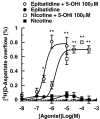
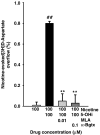

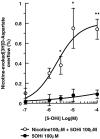

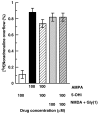
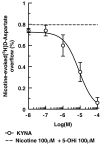
Similar articles
-
P2X(7) receptors exert a permissive role on the activation of release-enhancing presynaptic alpha7 nicotinic receptors co-existing on rat neocortex glutamatergic terminals.Neuropharmacology. 2006 May;50(6):705-13. doi: 10.1016/j.neuropharm.2005.11.016. Epub 2006 Jan 19. Neuropharmacology. 2006. PMID: 16427662
-
Presynaptic kynurenate-sensitive receptors inhibit glutamate release.Eur J Neurosci. 2001 Jun;13(11):2141-7. doi: 10.1046/j.0953-816x.2001.01592.x. Eur J Neurosci. 2001. PMID: 11422455
-
Presynaptic alpha7 and non-alpha7 nicotinic acetylcholine receptors modulate [3H]d-aspartate release from rat frontal cortex in vitro.Neuropharmacology. 2005 Jul;49(1):59-72. doi: 10.1016/j.neuropharm.2005.01.030. Epub 2005 Apr 21. Neuropharmacology. 2005. PMID: 15992581
-
Modulatory role of presynaptic nicotinic receptors in synaptic and non-synaptic chemical communication in the central nervous system.Brain Res Brain Res Rev. 1999 Nov;30(3):219-35. doi: 10.1016/s0165-0173(99)00016-8. Brain Res Brain Res Rev. 1999. PMID: 10567725 Review.
-
Kynurenic acid as an antagonist of α7 nicotinic acetylcholine receptors in the brain: facts and challenges.Biochem Pharmacol. 2013 Apr 15;85(8):1027-32. doi: 10.1016/j.bcp.2012.12.014. Epub 2012 Dec 25. Biochem Pharmacol. 2013. PMID: 23270993 Free PMC article. Review.
Cited by
-
Targeting brain α7 nicotinic acetylcholine receptors in Alzheimer's disease: rationale and current status.CNS Drugs. 2014 Nov;28(11):975-87. doi: 10.1007/s40263-014-0201-3. CNS Drugs. 2014. PMID: 25248971 Review.
-
Specific inhibition of kynurenate synthesis enhances extracellular dopamine levels in the rodent striatum.Neuroscience. 2009 Mar 3;159(1):196-203. doi: 10.1016/j.neuroscience.2008.11.055. Epub 2008 Dec 16. Neuroscience. 2009. PMID: 19138730 Free PMC article.
-
Kynurenines and Glutamate: Multiple Links and Therapeutic Implications.Adv Pharmacol. 2016;76:13-37. doi: 10.1016/bs.apha.2016.01.005. Epub 2016 Mar 11. Adv Pharmacol. 2016. PMID: 27288072 Free PMC article. Review.
-
Kynurenines in the mammalian brain: when physiology meets pathology.Nat Rev Neurosci. 2012 Jul;13(7):465-77. doi: 10.1038/nrn3257. Nat Rev Neurosci. 2012. PMID: 22678511 Free PMC article. Review.
-
The astrocyte-derived alpha7 nicotinic receptor antagonist kynurenic acid controls extracellular glutamate levels in the prefrontal cortex.J Mol Neurosci. 2010 Jan;40(1-2):204-10. doi: 10.1007/s12031-009-9235-2. Epub 2009 Aug 19. J Mol Neurosci. 2010. PMID: 19690987 Free PMC article.
References
-
- Alkondon M, Pereira EFR, Yu P, Arruda EZ, Almeida LEF, Guidetti P, et al. Targeted deletion of the kynurenine aminotransferase II gene reveals a critical role of endogenous kynurenic acid in the regulation of synaptic transmission via α7 nicotinic receptors in the hippocampus. J Neurosci. 2004;24:4635–4648. - PMC - PubMed
-
- Baran H, Jellinger K, Deecke L. Kynurenine metabolism in Alzheimer's disease. J Neural Transm. 1999;106:165–181. - PubMed
-
- Beal MF, Matson WR, Storey E, Milbury P, Ryan EA, Ogawa T, et al. Kynurenic acid concentrations are reduced in Huntington's disease cerebral cortex. J Neurol Sci. 1992;108:80–87. - PubMed
-
- Court J, Martin-Ruiz C, Piggott M, Spurden D, Griffiths M, Perry E. Nicotinic receptor abnormalities in Alzheimer's disease. Biol Psychiatry. 2001;49:175–184. - PubMed
Publication types
MeSH terms
Substances
LinkOut - more resources
Full Text Sources
Miscellaneous

